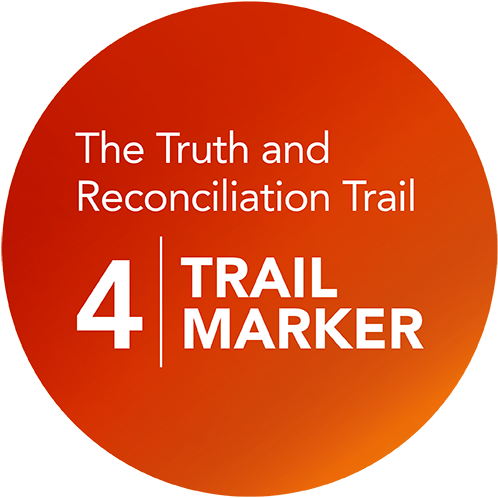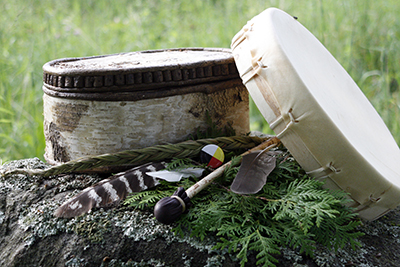Indigenous People of this land: Past, present and future
Truth and Reconciliation Trail | Marker 3
Learn how Indigenous Peoples have inhabited the land that is beneath your feet. What was once home to the Wendat Nation has become the traditional territory of the Anishinaabeg. Walk through the through the past, present, and future to learn more about Indigenous People of the Simcoe County Region of today.
Past
Indigenous life in the past was highly structured and complex, with each nation governing and living differently in comparison to others. Some nations were hunter-gathering, some were predominantly agrarian; some were matrilineal and others patrilineal. The clan system of governance and the concept of separate spheres of work for different groups are like other Indigenous nations worldwide. It’s estimated that prior to contact with Europeans, there were approximately 450 languages and dialects spoken by Indigenous Peoples throughout the land that is now called Canada.
Although each nation had different cultural and spiritual practices, there were many commonalities between nations across North America. These similarities included creation stories and a strong connection to living in harmony with land, water, vegetation and other beings in the natural world.
Above all else, the concept of kinship was important to many First Nations, including to their trade and their way of life. Kinships could come from birth, they could be attained through marriage, or they could be created through ceremony. Once kinship was established, alliances and trade could occur between various Nations. These kinships would need to be renewed for the relationship to continue.
Since time immemorial, Anishnaabeg fished, hunted, and trapped along the Great Lakes region. Following a series of prophecies called the Seven Fires, Anishnaabeg migrated along the Great Lakes. Some Anishnaabeg travelled to what is now Southern Ontario.
In this region, waterways were the highways of the past – they allowed for travel and trade between diverse nations. Trade routes existed across North America as shown through archeological evidence and oral histories. Many waterways in the Simcoe County Region, including Lake Simcoe itself, were important routes for the trading of goods. At Lake Simcoe, Anishnaabeg set up fishing weirs. Some of these 4000-year-old weirs remain intact at the north end of the Lake. The fishing weir was an important meeting place for the Anishnaabeg and other Nations to discuss treaties and trade.
The Indigenous People of this area ate fish along with wild game, wild rice, berries, leeks, ginger, beans, squash, nuts, and various plants that were either Indigenous to these lands or acquired through trade. Maintaining a harmonious relationship with the land, plants, fish, birds and animals was a way of life and key to survival. Animals were viewed as relatives and life sustainers to be respected and honoured. The natural world was the source of medicines as well as sustenance, making the First Peoples original botanists of these territories.
Each Indigenous nation has its own original legal framework and system of governance. The Anishnaabeg Nation, formerly the Union of Ontario Indians, is considered the oldest political organization in Ontario. Long before European contact, the Three Fires Confederacy was formed. The Three Fires Confederacy is an Anishnaabeg alliance that came together for political purposes to ensure the health and prosperity of their Nations and the land for future generations. The Three Fires Confederacy includes the Odawa, Ojibwe, and Pottawatomi nations.
In terms of education of the past, learning took place on the land and the land itself was seen as a teacher. Many Anishnaabeg follow an oral tradition, and knowledge is passed down through the generations.
The ways of Indigenous ancestors of the past continue to be honoured today.

Present
Indigenous ancestors of the past have paved a pathway for Indigenous People of today to thrive. The footsteps of Indigenous ancestors have marked the Southern Georgian Bay region for many millennia. Today, there are 8 First Nation communities and a thriving Metis community along with a growing urban population in the region.
The 8 First Nations within the area include: Chippewas of Georgina Island First Nation, Chippewas of Rama First Nation, Beausoleil First Nation, Saugeen First Nation, Chippewas of Nawash First Nation, Wahta Mohawk Territory, Moose Deer Point First Nation, and Wasauksing First Nation.
In the region, there are two Metis Nation of Ontario communities that provides a home for its citizens, including the Georgian Bay Metis Council and the Barrie-South Simcoe Metis Council.
In urban areas of the region, there are several organizations to support diverse Indigenous People who come from many different Nations. Some of these organizations include Friendship Centres such as The Barrie Native Friendship Centre, the Muskoka Indigenous Friendship Centre, and the Georgian Bay Native Friendship Centre. There are also organizations such as the Barrie Area Native Advisory Circle, Enaahtig Healing Lodge and Learning Centre, and the Georgian Bay Native Womens ‘Association.
At Georgian College, there are Wiidookdaading Indigenous Resource Centres located at Barrie, Midland, Orillia, and Owen Sound. These centres provide students with a culturally supportive community during their studies. For many Indigenous students at Georgian College today, these centres have become a home away from home. Like their ancestors before them, these students are carving out a future for their families, communities, and decedents.
Future
The 2021 Canada Census indicated that there are 42,940 people of Indigenous ancestry who reside in the Southern Georgian Bay region. However, this number continues to grow. Indigenous People today are the fastest growing and youngest demographic of the Canadian population. This demographic is growing twice the rate of non-Indigenous Canadians.
What this means is that Indigenous youth of today will be building an even better tomorrow founded on their values and aspirations. This can only happen so long as their ideas are supported, and systemic barriers are broken down. When this is done, the possibility for Indigenous futures grows with each generation. Indigenous People will be increasingly represented in various fields such as health, sciences, education, justice, leadership, and much more.
Gathering truth
Reconcili-ACTION
Explore the Indigenous past, present, and future of the land you are on. There are a few ways you can explore this:
- Go to native-land.ca or whose.land and type your address
- Text your address to 907.312.5085
- Go to your town/city’s official website and see if they have a land acknowledgement statement
- Explore this map of First Nations in Ontario to see the one closest to you
After you find out whose land you are on, go deeper into learning about their past, present, and future. You can do this by attending a Pow Wow hosted by the community, seeking out opportunities for intercultural collaboration, being informed on their current issues and community stories, and supporting their forms of cultural resurgence. Find ways to make authentic and meaningful connections with the Original Peoples of the land you call “home”.
Continue your journey through the trail markers
Trail marker 4 | Exploration to Colonization
Imagine, vibrant Indigenous Nations across Turtle Island (North America) living with abundance, well established in areas such as resources, land stewardship, trade, food, education, spirituality, and self-governance. This was life prior to first contact with Europeans who arrived here relying on Indigenous People for survival and trade. Indigenous Nations eventually became obstacles to colonial expansion aimed at seizing land for European settlement and controlling resources. This would have devastating impacts on Indigenous People, including the Anishinaabeg, who were displaced from their traditional lands and forcibly assimilated into the encroaching Euro-Christian society.

